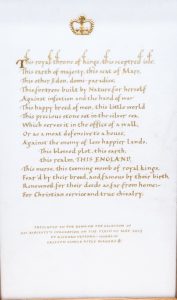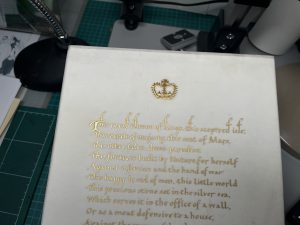 It’s not often that you’re asked to carry out a commission for The King to be presented to mark His Majesty’s Coronation, and it was such a privilege to be asked to do so. It was also a special privilege to be able to propose texts rather than this being prescribed. At the time of this request I was looking into suitable extracts for my latest book ‘The Art of the Scribe’ (published Spring 2025), and this quotation from Shakespeare – John of Gaunt’s speech from ‘Richard II’ seemed most apt. Starting with the phrase ‘This royal throne of kings …’ and with other appropriate regal references in the speech as well – it matched the occasion. (Admittedly, John of Gaunt is lamenting the decline of the realm under Richard II, but that section wasn’t included!)
It’s not often that you’re asked to carry out a commission for The King to be presented to mark His Majesty’s Coronation, and it was such a privilege to be asked to do so. It was also a special privilege to be able to propose texts rather than this being prescribed. At the time of this request I was looking into suitable extracts for my latest book ‘The Art of the Scribe’ (published Spring 2025), and this quotation from Shakespeare – John of Gaunt’s speech from ‘Richard II’ seemed most apt. Starting with the phrase ‘This royal throne of kings …’ and with other appropriate regal references in the speech as well – it matched the occasion. (Admittedly, John of Gaunt is lamenting the decline of the realm under Richard II, but that section wasn’t included!)
 Such a piece needed a lot of thought and preparation and I was keen to ensure that as many pertinent references were made. First, of course, it had to be on stretched vellum, and a beautiful skin was selected by William Cowley – the most perfect ivory-white. Then, without question, it had to be in gold – yellow shell gold – and with pure leaf gold on gesso as part of the composition. I tried it in my go-to Italic script and wrote out the whole passage as here.
Such a piece needed a lot of thought and preparation and I was keen to ensure that as many pertinent references were made. First, of course, it had to be on stretched vellum, and a beautiful skin was selected by William Cowley – the most perfect ivory-white. Then, without question, it had to be in gold – yellow shell gold – and with pure leaf gold on gesso as part of the composition. I tried it in my go-to Italic script and wrote out the whole passage as here.
 This, though, was too ‘blocky’, and, on re-reading, it seemed that the speech was reaching a crescendo at ‘This blessed plot, this earth, this realm, this England’ (you can almost hear the actor’s voice rising in volume until the last two words are almost shouted). But writing each phrase on a separate line broke up the design too much.
This, though, was too ‘blocky’, and, on re-reading, it seemed that the speech was reaching a crescendo at ‘This blessed plot, this earth, this realm, this England’ (you can almost hear the actor’s voice rising in volume until the last two words are almost shouted). But writing each phrase on a separate line broke up the design too much.
 In the end I decided to write the four phrases in two lines, with ‘this England’ in capital letters. This seemed to work better. However, for this piece italic just didn’t seem right, so I went back to a script developed during the reign of another King Charles, actually a Holy Roman Emperor, that of Caroline Minuscule used in many manuscripts during the time of Charlemagne in the ninth century. But how would it look written in gold? I tried out the first line on an offcut of the vellum being used and it seemed to be just right.
In the end I decided to write the four phrases in two lines, with ‘this England’ in capital letters. This seemed to work better. However, for this piece italic just didn’t seem right, so I went back to a script developed during the reign of another King Charles, actually a Holy Roman Emperor, that of Caroline Minuscule used in many manuscripts during the time of Charlemagne in the ninth century. But how would it look written in gold? I tried out the first line on an offcut of the vellum being used and it seemed to be just right.
 The gesso crown was rather tricky as it was so small (about 1·5 cm) and only a nodding representation could be made to the pearls atop the arches of the crown, and the fleur-de-lis and crosses patey which rise from the gold rim. The different shine on this part of the piece echoed but also contrasted that of the shell gold.
The gesso crown was rather tricky as it was so small (about 1·5 cm) and only a nodding representation could be made to the pearls atop the arches of the crown, and the fleur-de-lis and crosses patey which rise from the gold rim. The different shine on this part of the piece echoed but also contrasted that of the shell gold.
 It was framed in Sandringham oak – wood saved from an ancient oak tree in the parkland which would have resonated with His Majesty for whom, we know, it is a very special place. The letter received back by Gallyon indicated that King ‘was touched to receive this beautiful piece of commemorative art’. And I felt that it was a real honour to have been asked complete it.
It was framed in Sandringham oak – wood saved from an ancient oak tree in the parkland which would have resonated with His Majesty for whom, we know, it is a very special place. The letter received back by Gallyon indicated that King ‘was touched to receive this beautiful piece of commemorative art’. And I felt that it was a real honour to have been asked complete it.












































































